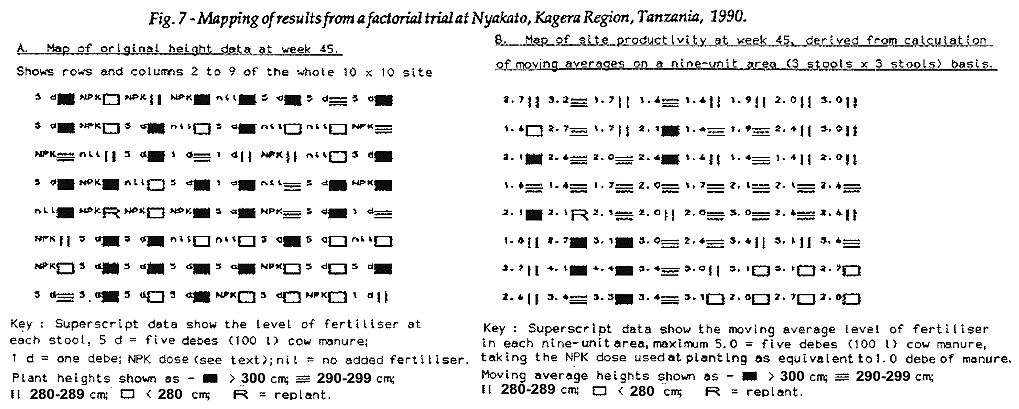The Bananas of Upland East Africa - FIELD TRIALS PROGRESS AND RESULTS UP TO MAY 1990 |
A key motive when planning the factorial trials, at Nyakato and Kibeta, was to test the merits of an experimental design using single stools as replicates and a completely randomised layout. The results shown below in FIGURE 6 and FIGURE 7 indicate that the design is an effective technique.


Firstly, taking the two sites together, the coefficients of variation per treatment for mean height or girth were below 12% in 80 out of 120 instances, below 15% in 100 out of 120 instances, and over 20% in only the two no-fertiliser treatments at Kibeta. Thus, the within-treatment variation was of no great importance, whereas the between-treatments variations were highly significant (F = 1%). The acceptability for coefficients of variation in banana field trials appears not to have been commented on in the literature but GOMEZ & GOMEZ (1976), from extensive rice trials experience, regard CV levels for yield of 10-12% as the aim in fertiliser trials and about 15% in insecticide trials. The CV levels where that for yield is about 10%, in their experience, would be about 20% for tiller number and about 3% for plant height. The sucker numbers in the present factorial trials are like the rice tiller numbers in being quite variable but, even with the high fertiliser treatments, one is dealing with only relatively small numbers of suckers.
Secondly, a simple visual check of the maps of plant heights and fertiliser levels at Kibeta (FIGURE 6a) and Nyakato (FIGURE 7a) shows few instances where the heights differ greatly from the mean for the particular level of fertiliser incorporated in the planting hole; in other words, there were no obvious edge or inter-hole effects.
Thirdly, to test for within-site variation affecting plant growth, the measurements of plant heights were transformed in the manner used for one form of evaluation of soil heterogeneity - the use of moving averages of contiguous units (GOMEZ & GOMEZ 1976). This was done for nine-unit areas (3 stools x 3 stools) so that, after exclusion of the outer rows and colums, moving averages were obtained for 64 stools at each site. The results are shown as productivity maps (FIGURES 6b and 7b) and the postulate is that the effect of randomisation would be to even out any differences due to the treatments. At Nyakato there was a cluster of low heights in one corner of the site which seems unlikely to be related to fertiliser level. At Kibeta there was a concentration of the highest moving averages in one corner of the site, but this seems most likely to be an accident of the completely random design in giving a cluster of stools with the highest level of fertiliser. In addition, the moving averages were sorted according to the treatment applied to the central stool of the unit area and an analysis of variance was calculated for each site. At Nyakato the variations between treatments now were not significant. At Kibeta the differences between treatments were significant (F = 5%) but the ranking of treatments (using Duncan's multiple range test) did not reflect the fertiliser levels.
Taking the foregoing together, at both sites the random allocation of treatments was wholly satisfactory.
So, by using single stools as replicates, the promise is of achieving reliable and dependable results from trials with site areas of only 30m x 30m (0.09 ha).
The alternative, "traditional" concept of having to use a randomised complete block design would require a site area of 60m x 96m (0.58 ha) to enable comparison of ten treatments, with four replicates and 16 stools per plot. Thus, the cost and time demands of the "traditional" practice are more than six time as much. When the desirability of conducting trials on farmers' land compared to the rather artificial conditions often prevailing on experimental stations, is taken into account, the near impossibility of finding 0.6 ha of land for a trial is obvious to anyone familiar with subsistence agriculture.
| ©2000 - Brian Taylor CBiol FIBiol
FRES 11, Grazingfield, Wilford, Nottingham, NG11 7FN, U.K. Visiting Academic in the Department of Life Science, University of Nottingham |
href="\bananas2000\analyse7.htm"